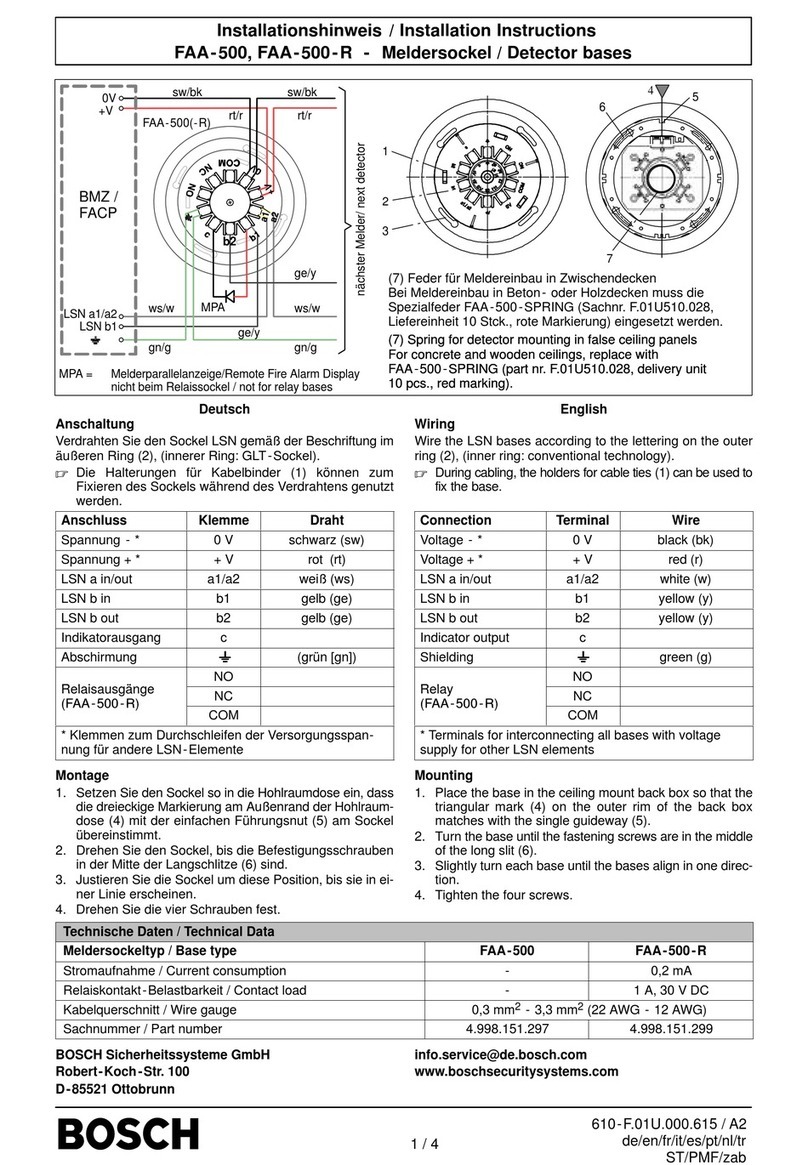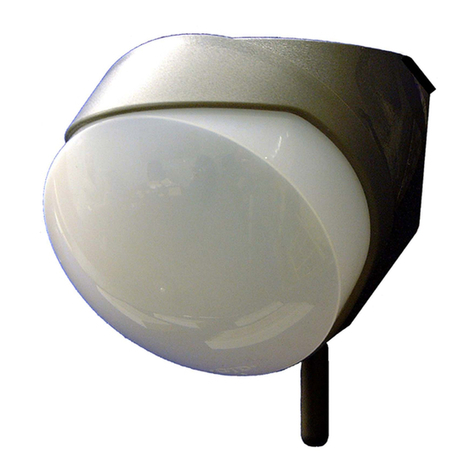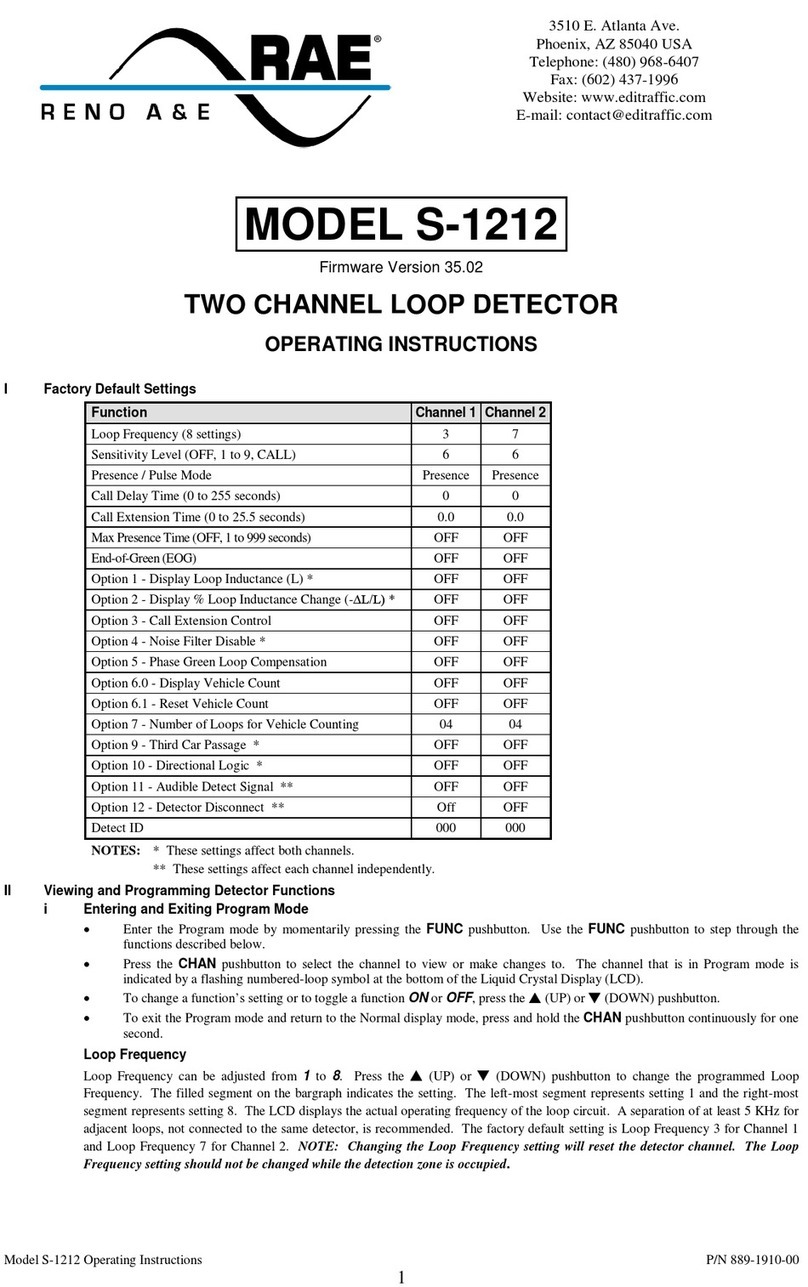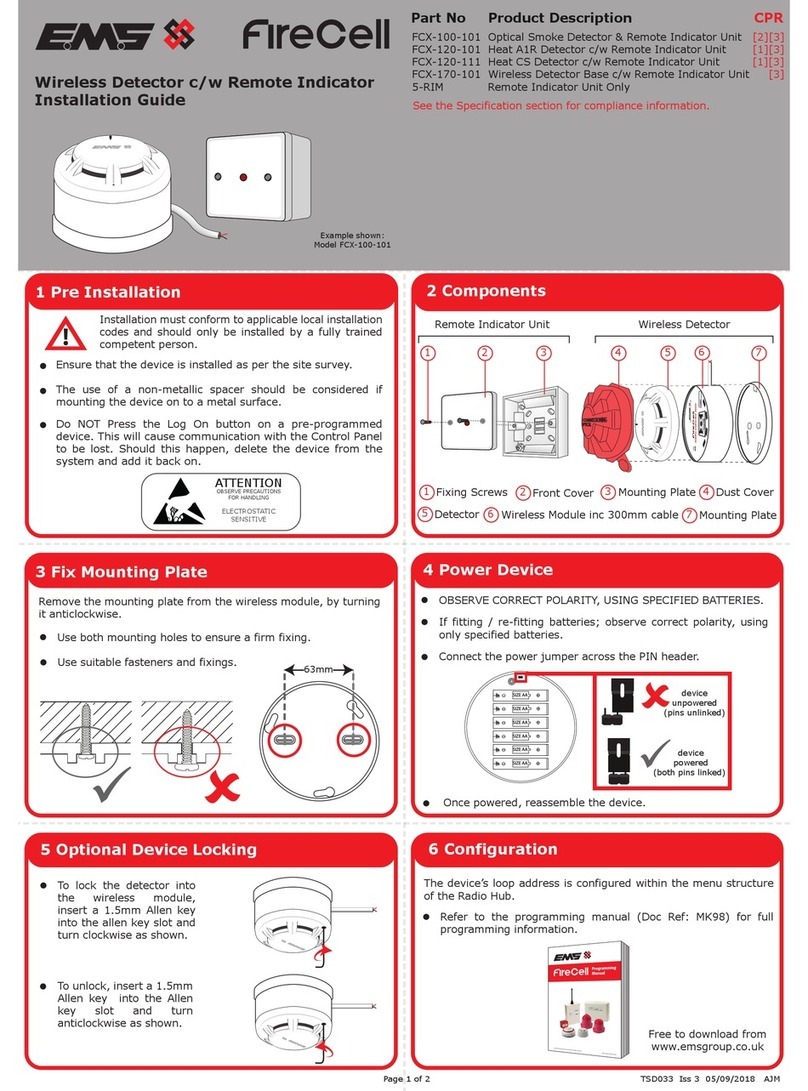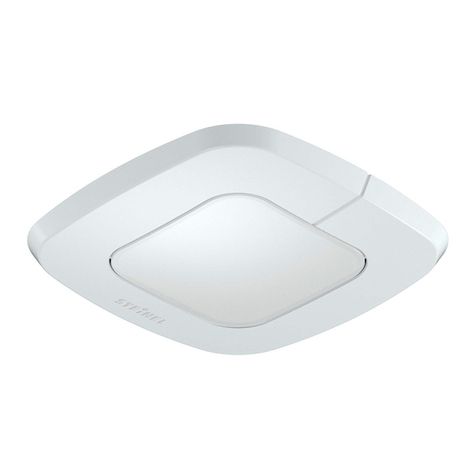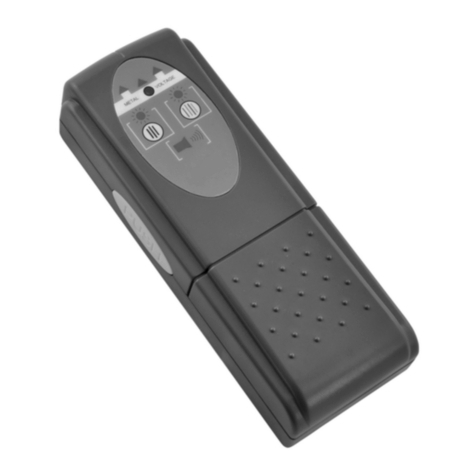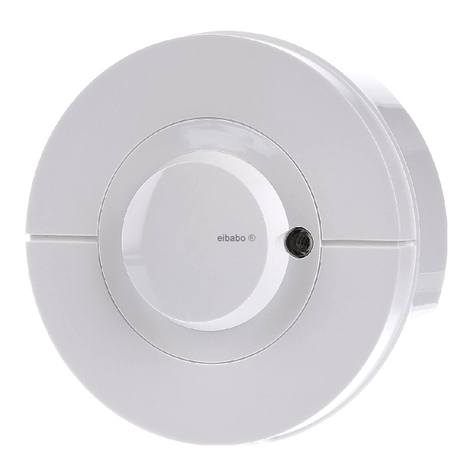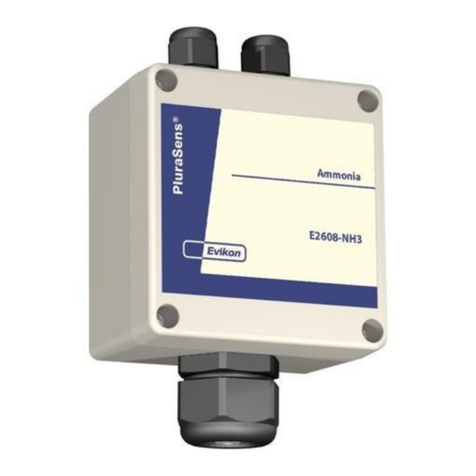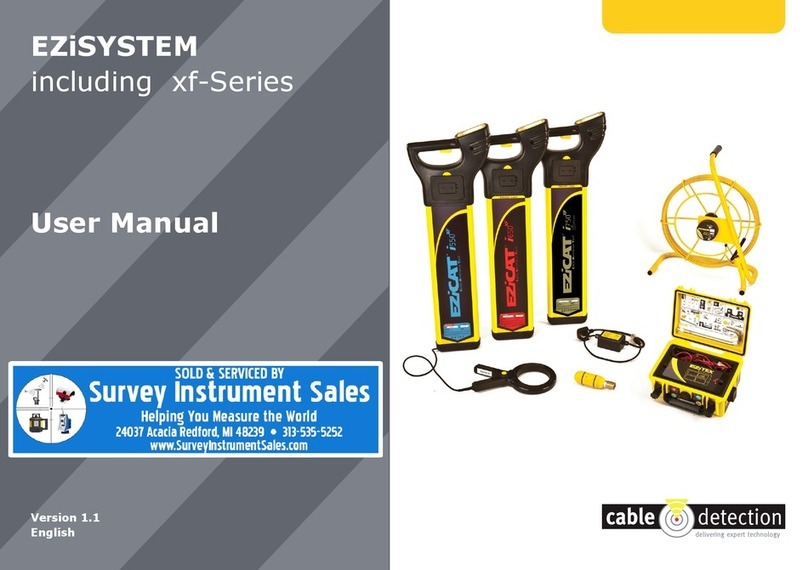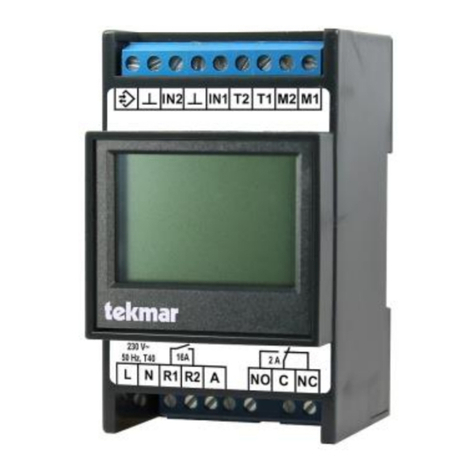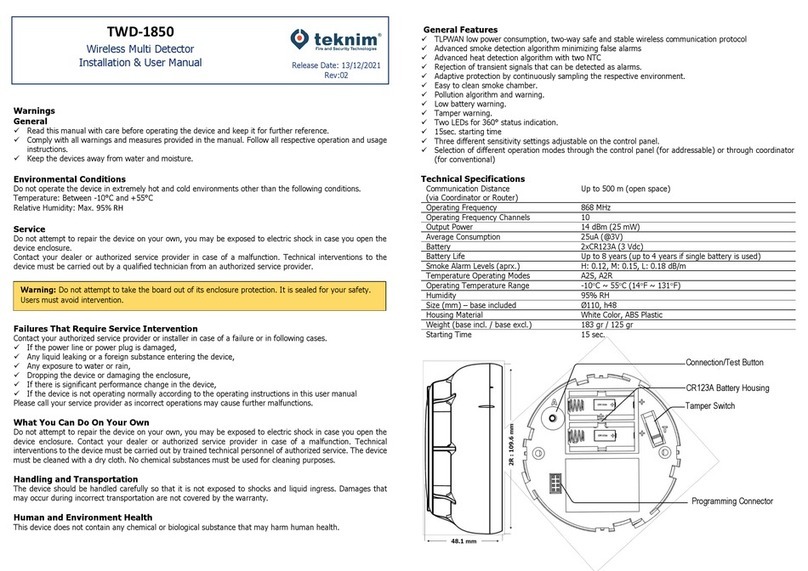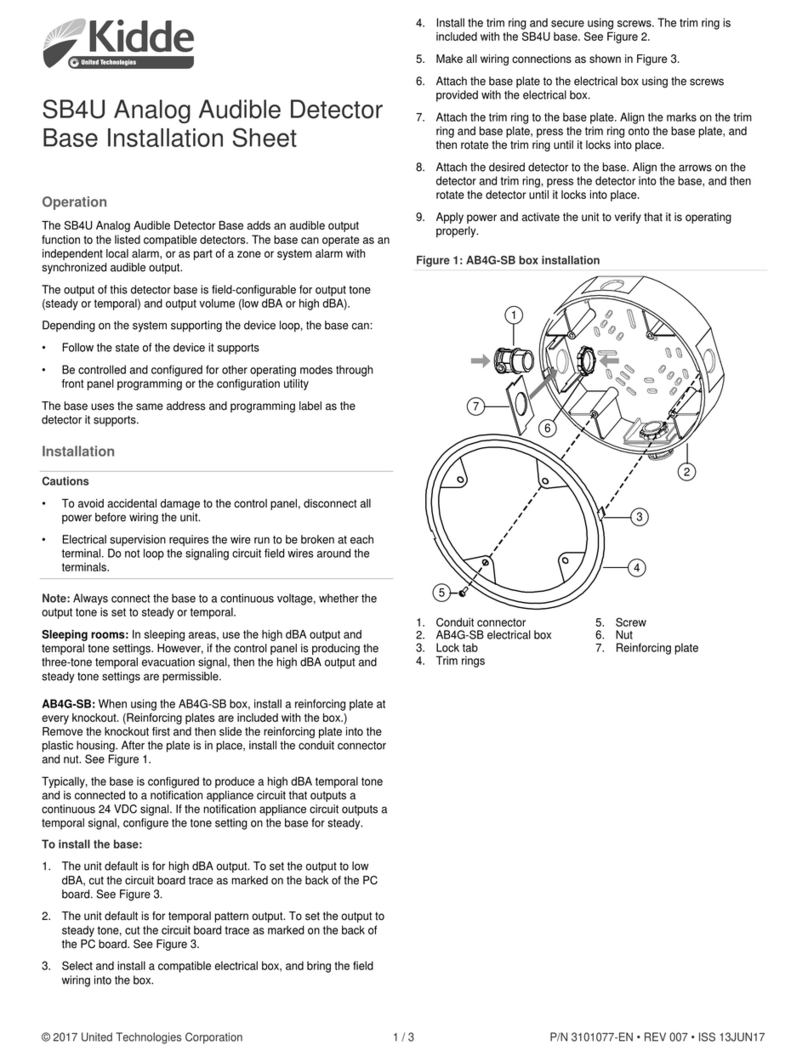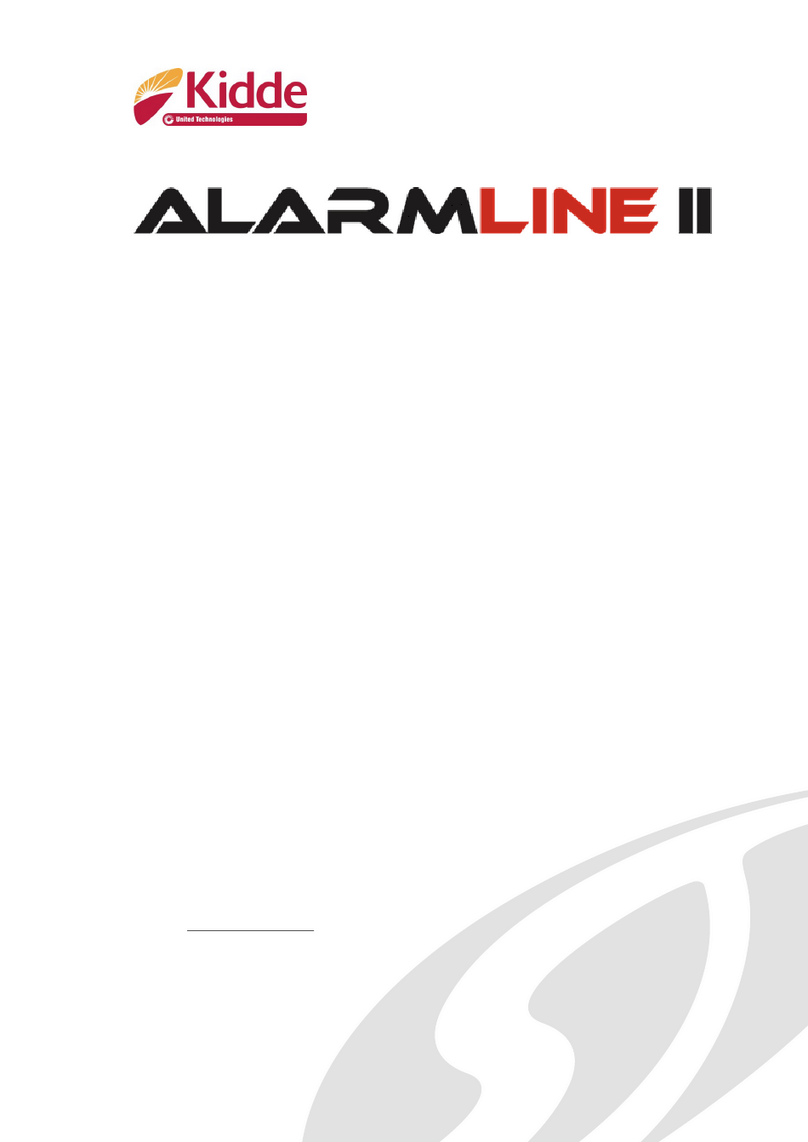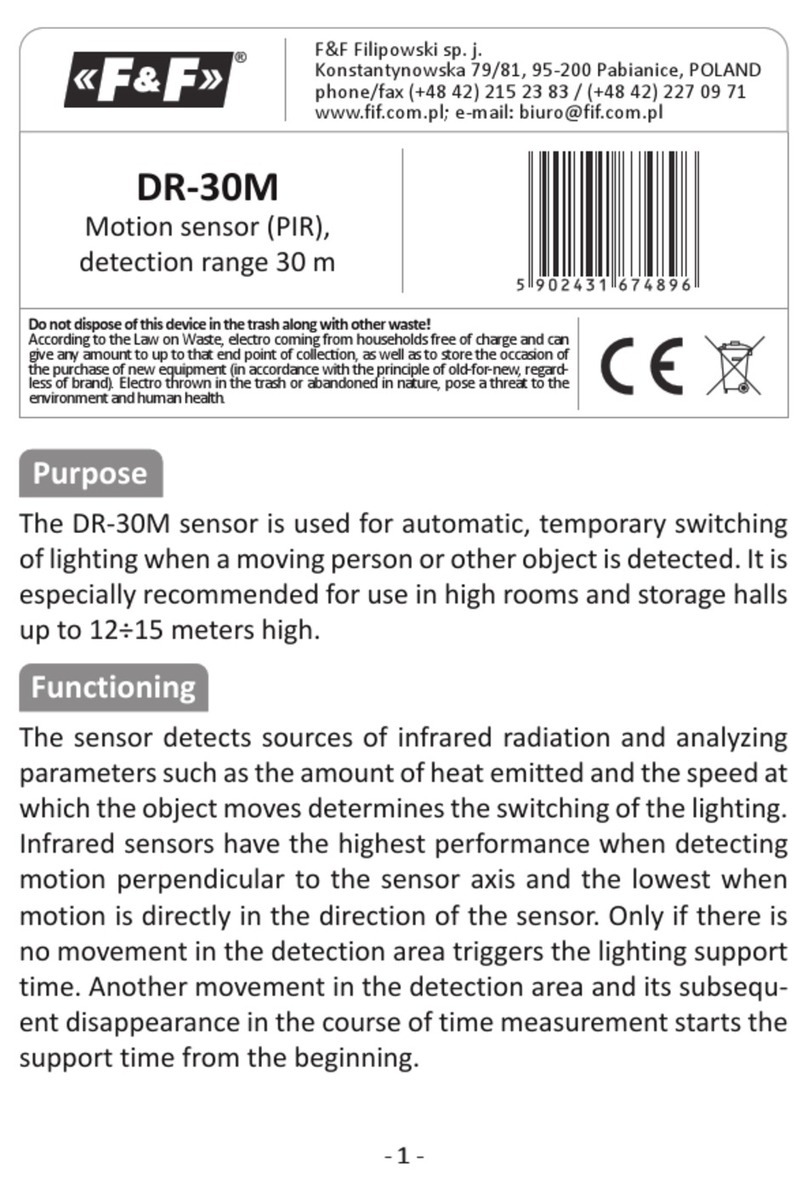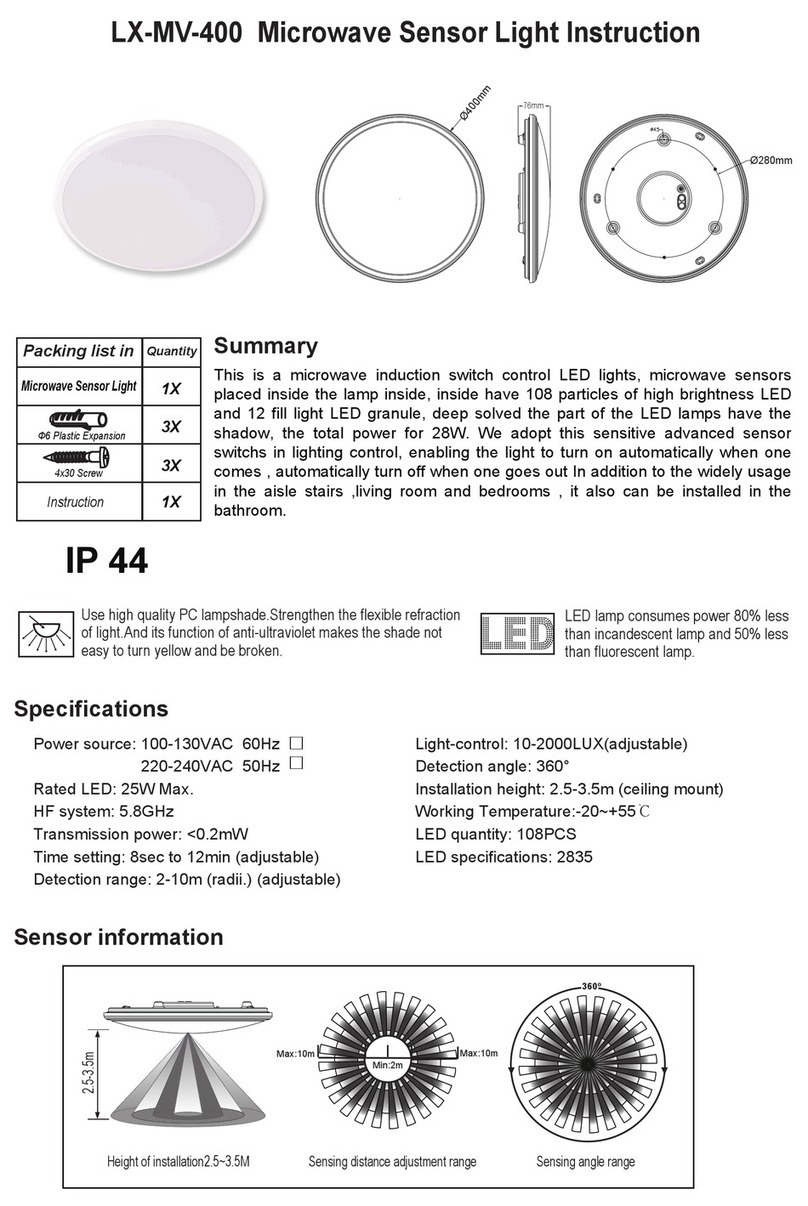TRIGA TR-PC2RL User manual

1 I56-5846TRG-003
2/1/2021
BEFORE INSTALLING
Please read the System Sensor Audible Visible Application Reference Guide,
which provides detailed information on notification devices, wiring and spe-
cial applications. Copies of this manual are available from System Sensor.
NFPA 72 and NEMA guidelines should be observed.
Important: The notification appliance used must be tested and maintained
following NFPA 72 requirements.
GENERAL DESCRIPTION
These notification appliances offer a wide range of audible and visible devices
for life safety notification. Our 2-wire horn strobes, chime strobes and strobes
come with 8 field selectable tone and volume combinations and 7 field select-
able candela settings. Intended for indoor applications and approved for ceil-
ing mount installations.
These 2-wire horn strobes and strobes are public mode notification appliances
intended to alert occupants of a life safety event. The 2-wire chime strobe
is a private mode notification appliance. The horn is listed to ANSI/UL 464
requirements (public mode) and the strobe is listed to ANSI/UL 1638 (public
mode). 2-wire chime strobe is a private mode notification appliances intended
to alert trained personnel to investigate a life safety event and take appropriate
actions. The chime portion of the chime strobe is listed to ANSI/UL 464 (pri-
vate mode) and the strobe portion is listed to ANSI/UL 1638 (private mode).
These strobes are designed to be used in 12 VDC, 24VDC, or 24V FWR (full
wave rectified) systems. AV devices can be activated by a compatible Triga
fire alarm control panel or power supply. Refer to the appropriate fire alarm
control panel manufacturer or power supply for more information.
These ceiling 2-wire horn strobes, 2-wire chime strobes, and strobes come
enabled with System Sensor synchronization protocol which requires connec-
tions to a power supply capable of generating the System Sensor synchroniza-
tion pulses, a FACP NAC output configured to System Sensor synchronization
protocol, or the use of MDL3 module to generate the synchronization protocol.
FIRE ALARM SYSTEM CONSIDERATIONS
The National Fire Alarm and Signaling Code, NFPA 72, requires that all noti-
fication appliances, used for building evacuation installed after July 1, 1996,
produce temporal coded signals. Signals other than those used for evacuation
purposes do not have to produce the temporal coded signal. Triga recom-
mends spacing notification appliances in compliance with NFPA 72.
SYSTEM DESIGN
The system designer must make sure that the total current draw by the devices
on the loop does not exceed the current capability of the panel supply, and
that the last device on the circuit is operated within its rated voltage. The cur-
rent draw information for making these calculations can be found in the tables
within the manual.
When calculating the voltage available to the last device, it is necessary to
consider the voltage due to the resistance of the wire. The thicker the wire, the
smaller the voltage drop. Wire resistance tables can be obtained from electri-
cal handbooks. Note that if Class A wiring is installed, the wire length may
be up to twice as long as it would be for circuits that are not fault tolerant.
The total number of strobes on a single NAC must not exceed 69 for 24 volt
applications.
AVAILABLE TONES
These models offer a wide variety of tones for your life safety needs, including
temporal 3 pattern (½ second on, ½ second off, ½ second on, ½ second off,
½ second on, 1½ off and repeat) which is specified by ANSI and NFPA 72 for
standard emergency evacuation signaling.
To select the tone, turn the rotary switch on the back of the product to the
desired setting. (See Figure 1.) Available horn settings can be found in Table 1.
Available chime settings can be found in Table 2.
AVAILABLE CANDELA SETTINGS
These models offer a wide range of candela settings for your life safety needs.
In order to select your candela output, adjust the slide switch on the rear of the
product to the desired candela setting on the selector switch. (See Figure 2.)
The candela setting can also be verified by looking into the small window on
the front of the unit. See Table 3 for candela settings for ceiling products. All
products meet the light output profiles specified in the appropriate UL Stan-
dards. (See Figures 3 to 5.)
INSTALLATION AND MAINTENANCE INSTRUCTIONS
Selectable Output
Horn Strobes, Chime Strobes
and Strobes – Ceiling Mount
For use with the following models:
Ceiling Mount Horn Strobes: TR-PC2RL, TR-PC2WL
Ceiling Mount Chime Strobes: CHSCRL, CHSCWL
Ceiling Mount Strobes: TR-SCRL, TR-SCWL, SCWL-CLR-ALERT, SCRL-P, SCWL-P
PRODUCT SPECIFICATIONS
Standard Operating Temperature: 32°F to 120°F (0°C to 49°C)
Humidity Range: 10 to 93% Non-condensing
Strobe Flash Rate 1 flash per second
Nominal Voltage: Regulated 12VDC or regulated 24DC/FWR
Operating Voltage Range: 8 to 17.5V (12V nominal) or 16 to 33V (24V nominal)
Operating Voltage with MDL3 Sync Module: 8.5 to 17.5V (12V nominal) or 16.5 to 33V (24V nominal)
Input terminal wire gauge: 12 to 18 AWG
DIMENSIONS FOR PRODUCTS AND ACCESSORIES MOUNTING BOX OPTIONS
CEILING PRODUCTS Diameter Depth
2-Wire Indoor Products
Strobe, Chime Strobe and Horn Strobe
6.83"
(173.5mm)
2.47"
(62.7mm)
4" x 4" x 1½", Single Gang, Double Gang,
4" Octagon, SBBCRL/WL (ceiling)
Strobe, Chime Strobe, and Horn Strobe with
SBBCRL/WL Surface Mount Back Box
6.92"
(175.8mm)
2.50"
(63.5mm)
NOTICE: This manual shall be left with the owner/user of this equipment.
I56-5846TRG-003
TRIGA Life Safety Systems, LLC
7600 Olde Eight Rd.
Hudson, Ohio 4426-1057

2 I56-5846TRG-003
2/1/2021
FIGURE 3. LIGHT OUTPUT - VERTICAL DISPERSION, CEILING TO WALLS
TO FLOOR
Degrees* Percent of
Rating
0100
5-25 90
30-45 75
50 55
60 45
65 35
70 35
75 30
80 30
85 25
90 25
FIGURE 4. LIGHT OUTPUT – FIGURE 5. VERTICAL
HORIZONTAL DISPERSION DISPERSION, WALL TO FLOOR
Degrees* Percent of Rating Degrees* Percent of Rating
0100 0100
5-25 90 5-30 90
30-45 75 35 65
50 55 40 46
55 45 45 34
60 40 50 27
65 35 55 22
70 35 60 18
75 30 65 16
80 30 70 15
85 25 75 13
90 25 80 12
Compound 45
to the left 24 85 12
Compound 45
to the right 24 90 12
A0467-00
A0469-00
*Tolerance of ±1 degree is permitted.
Thisisgenerated textforfigtxt.
FIGURE 1. AUDIO SELECTOR
A0518.00
FIGURE 2. CANDELA SELECTOR
A0486-00
TABLE 1. HORN TONES TABLE 2. CHIME TONES
Pos Tone Volume
Setting Pos Tone Volume
Setting
1 Temporal High 1 1 Second Chime High
2 Temporal Low 2 1 Second Chime Low
3 Non-Temporal High 3 ¼ Second Chime High
4 Non-Temporal Low 4 ¼ Second Chime Low
53.1 KHz
Temporal High 5 Temporal Chime High
63.1 KHz
Temporal Low 6 Temporal Chime Low
73.1 KHz
Non-Temporal High 7 5 Second Whoop High
83.1 KHz
Non-Temporal Low 8 5 Second Whoop Low
TABLE 3. CEILING-MOUNT STROBE CURRENT DRAW (mA)
Candela
8-17.5
Volts 16-33 Volts
DC DC FWR
15 87 41 60
NOTE: Products set at 15 and 30
candela automatically work on
either 12V or 24V power supplies.
The products are not listed for
12V DC operation when set to any
other candela settings.
30 153 63 86
75 - 111 142
95 - 134 164
11 5 - 158 191
150 - 189 228
177 - 226 264
CURRENT DRAW AND AUDIBILITY RATINGS
For the horn strobe, the current draw and audibility ratings for each setting is
listed in Table 4. For the chime strobe, the current draw and audibility ratings
for each setting is listed in Table 5. For the strobe, the current draw for each
setting is listed in Table 3.
TABLE 4. CEILING--MOUNT HORN STROBE CURRENT DRAW (mA) AND SOUND OUTPUT (dBA)
Current draw (mA)
Sound Output (dBA)
Pos Tone Volume
Setting
8-17.5 VDC 16-33 VDC 16-33 FWR
8-17.5 V 16-33 V
15 30 15 30 75 95 115 150 177 15 30 75 95 115 150 177
DC DC FWR
1 Temporal High 103 167 71 90 143 165 187 217 254 107 135 179 198 223 254 286 84 89 89
2 Temporal Low 96 165 54 71 137 161 185 211 249 78 101 151 172 199 229 262 75 83 83
3 Non-Temporal High 106 173 71 90 141 165 187 230 273 107 135 179 198 223 254 286 85 90 90
4 Non-Temporal Low 95 166 54 71 124 161 170 216 258 78 101 151 172 199 229 262 76 84 84
53.1 KHz
Temporal High 111 164 69 94 147 163 184 229 257 108 135 179 200 225 255 289 83 88 88
63.1 KHz
Temporal Low 103 163 54 88 143 155 185 212 252 79 101 150 171 196 229 260 76 82 82
73.1 KHz
Non-Temporal High 111 172 69 94 144 164 202 229 271 108 135 179 200 225 255 289 84 89 89
83.1 KHz Non-
Temporal Low 103 169 54 88 131 155 187 217 259 79 101 150 171 196 229 260 77 83 83
NOTE: Products set at 15 and 30 candela automatically work on either 12V or 24V power supplies. The products are not listed for 12VDC operation when set to
any other candela settings.
A0468-00

3 I56-5846TRG-003
2/1/2021
WIRING AND MOUNTING
All wiring must be installed in compliance with the National Electric Code
and the local codes as well as the authority having jurisdiction. Wiring must
not be of such length or wire size which would cause the notification appli-
ance to operate outside of its published specifications. Improper connections
can prevent the system from alerting occupants in the event of an emergency.
Wire sizes up to 12 AWG (2.5 mm²) may be used with the mounting plate. The
mounting plate ships with the terminals set for 12 AWG wiring.
Make wire connections by stripping about
3
/
8
"of insulation from the end of
the wire. Then slide the bare end of the wire under the appropriate clamping
plate and tighten the clamping plate screw. We provide a wire strip guide. See
Figure 6 for wiring terminals and strip guide reference.
CAUTION
Factory finish should not be altered: Do not paint!
CAUTION
Do not over tighten mounting plate screws; this may cause mounting plate
to flex.
FIGURE 6. WIRING TERMINALS, SHORTING SPRING, AND STRIP GUIDE
Shorting Spring
Strip Guide
WIRING TERMINALS
1. Negative (-). Line in and out
2. Positive (+). Line in and out
3. Positive (+). Line in and out
A0475-01
SYSTEM WIRING
The 2-wire horn strobe, chime strobe and strobe only require two wires for
power and supervision. (See Figure 7.) Please consult your FACP manufac-
turer or power supply manufacturer for specific wiring configurations and
special cases.
+
–
+
–
INPUT
FROM
FACP
OR
PRIOR
DEVICE
OUTPUT
TO
NEXT
DEVICE
OR EOL
FIGURE 7. 2-WIRE CIRCUIT
A0367-02
SHORTING SPRING FEATURE
These notification appliances come with a shorting spring that is provided be-
tween terminals 2 and 3 of the mounting plate to enable system continuity
checks after the system has been wired, but prior to installation of the final
product. (See Figure 6.) This spring will automatically disengage when the
product is installed, to enable supervision of the final system.
MOUNTING AND REMOVING APPLIANCE
1. Attach mounting plate to junction box using two of the provided Philips
head screws. (See Figure 8.)
2. Connect field wiring according to terminal designations. (See Figures 6
and 7.)
3. If the product is not to be installed at this point, use the protective dust
cover to prevent contamination of the wiring terminals on the mounting plate.
4. To attach product to mounting plate:
a. Remove the protective dust cover.
b. Hook the tabs on the top of the product housing into the grooves on mount-
ing plate.
c. Pivot the product into position to engage the terminals on the mounting
plate. Make sure that the tabs on the back of the product housing fully en-
gage with the mounting plate.
d. Hold product in place with one hand, and secure product by tightening the
single mounting screw in the front of the product housing.
Ceiling Models only: To remove product from the mounting plate, loosen the
captive mounting screw and press the locking button.
FIGURE 8. MOUNTING
A0492-01
Locking
button
A0574-00
TABLE 5. CEILING-MOUNT CHIME STROBE CURRENT DRAW (mA) AND SOUND OUTPUT (dBA)
Current draw (mA)
Sound Output (dBA)
Pos Chime Tone Volume
Setting
8-17.5 VDC 16-33 VDC 16-33 FWR
8-17.5 V 16-33 V
15 30 15 30 75 95 115 150 177 15 30 75 95 115 150 177
DC DC FWR
1 1 Second High 96 165 47 69 11 7 137 165 202 238 63 90 147 169 184 212 245 61 62 62
2 1 Second Low 93 162 47 68 11 6 137 165 200 238 63 88 147 169 183 212 244 56 55 55
3 ¼ Second High 94 161 48 70 11 7 138 166 202 237 65 90 149 170 184 21 3 246 67 70 70
4 ¼ Second Low 93 157 48 69 11 6 137 164 199 236 64 89 148 168 184 216 244 61 61 61
5 Temporal High 93 163 48 70 11 6 138 165 199 238 64 89 148 169 184 212 245 64 66 66
6 Temporal Low 92 160 47 69 11 6 136 164 198 237 63 88 147 169 183 212 245 59 60 60
75 Second
Whoop High 98 169 54 77 124 146 173 206 245 75 100 155 178 193 221 255 76 78 78
85 Second
Whoop Low 95 166 49 71 11 7 144 168 202 239 68 91 148 170 186 217 248 62 64 64
NOTE: Products set at 15 and 30 candela automatically work on either 12V or 24V power supplies. The products are not listed for 12VDC operation when set to
any other candela settings.

4 I56-5846TRG-003
©2021. 2/1/2021
TAMPER SCREW
For tamper resistance, the standard captive screw may be replaced with a Torx
screw (sold separately).
1. To remove the captive screw, back out the screw and apply pressure to the
back of the screw until it disengages from the housing. Replace with Torx
screw. (See Figure 9.)
FIGURE 9. TAMPER SCREW
T15 Torx
#6-32, 5/8"
SCREW-TMPR-50
A0493-01
INSTALLING A SURFACE MOUNT BACK BOX
1. The ceiling surface mount back box may be secured directly to the wall
or ceiling. Use of grounding bracket with ground screw is optional. (See
Figure 10.)
2. The ceiling mount box can be used on ceiling horn strobe, chime strobe,
strobe as well as ceiling speaker and speaker strobe models. Use the STR cut-
outs for ceiling horn strobe, chime strobe and strobe installation needs. (See
Figure 11.)
3. Threaded knockout holes are provided for the sides of the box for ¾ inch
and ½ inch conduit adapter. Knockout holes in the back of the box can be
used for ¾ inch and ½ inch rear entry.
4. To remove the ¾ inch knockout, place the blade of a flat-head screwdriver
along the outer edge and work your way around the knockout as you strike
the screwdriver. (See Figure 12.)
NOTE: Use caution not to strike the knockout near the top edge of the
surface mount back box.
5. V500 and V700 raceway knockouts are also provided. Use V500 for low
profile applications and V700 for high profile applications.
6. To remove the knockout, turn pliers up. (See Figure 12.)
FIGURE 10. SURFACE MOUNTING ON CEILING
SBBCRL/SBBCWL
A0494-02
FIGURE 11. CUT-OUTS FOR SPEAKER (SPK) AND STROBE (STR)
A0495-00
FIGURE 12. KNOCKOUT AND V500/V700 REMOVAL FOR SURFACE
MOUNT BACK BOX
½ inch
or ¾ inch
Wire Mold Removal
A0465-01 A0466-01
Triga™ is a trademark of TRIGA Life Safety Systems, LLC. System Sensor®is a registered trademark of Honeywell International, Inc.
FCC STATEMENT
These Strobes and Horn/Strobes have been tested and found to comply with the limits for
a Class B digital device, pursuant to part 15 of the FCC Rules. These limits are designed
to provide reasonable protection against harmful interference when the equipment is
operated in a commercial environment. This equipment generates, uses, and can radiate
radio frequency energy and, if not installed and used in accordance with the instruction
manual, may cause harmful interference to radio communications. Operation of this
equipment in a residential area is likely to cause harmful interference in which case the
user will be required to correct the interference at his own expense.
The horn and/or strobe will not work without power. The horn/
strobe gets its power from the fire/security panel monitoring the
alarm system. If power is cut off for any reason, the horn/strobe
will not provide the desired audio or visual warning.
The horn may not be heard. The loudness of the horn meets (or
exceeds) current Underwriters Laboratories’ standards. However,
the horn may not alert a sound sleeper or one who has recently
used drugs or has been drinking alcoholic beverages. The horn
may not be heard if it is placed on a different floor from the person
in hazard or if placed too far away to be heard over the ambient
noise such as traffic, air conditioners, machinery or music appli-
ances that may prevent alert persons from hearing the alarm. The
horn may not be heard by persons who are hearing impaired.
NOTE: Strobes must be powered continuously for horn operation.
The signal strobe may not be seen. The electronic visual warning
signal uses an extremely reliable xenon flash tube. It flashes at least
once every second. The strobe must not be installed in direct sunlight
or areas of high light intensity (over 60 foot candles) where the visual
flash might be disregarded or not seen. The strobe may not be seen
by the visually impaired.
The signal strobe may cause seizures. Individuals who have posi-
tive photoic response to visual stimuli with seizures, such as persons
with epilepsy, should avoid prolonged exposure to environments in
which strobe signals, including this strobe, are activated.
The signal strobe cannot operate from coded power supplies.
Coded power supplies produce interrupted power. The strobe must
have an uninterrupted source of power in order to operate cor-
rectly. Triga recommends that the horn and signal strobe always
be used in combination so that the risks from any of the above
limitations are minimized.
WARNING
THE LIMITATIONS OF HORN/STROBES
SUPPLEMENTAL INFORMATION
For Limitations of Fire Alarm Systems,
please go to:
http://www.systemsensor.com/
en-us/Documents/I56-1558.pdf
Limitations of
Fire Alarm Systems
This manual suits for next models
8
Other TRIGA Security Sensor manuals



